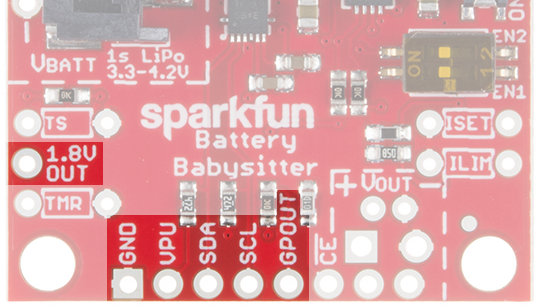Battery Babysitter Hookup Guide
LiPo Fuel Gauge
The Battery Babysitter's other predominant component is a BQ27441-G1A LiPo fuel gauge. With a highly sensitive analog-to-digital converter, it can measure a battery's voltage (mV) and state-of-charge (%). Plus, thanks to an external sense resistor, it can measure current (mA), power (mW), and even estimate remaining capacity (mAh).
The BQ27441 supports I2C, a two-wire serial interface, as its controlling interface. I2C is used to configure the fuel gauge with characteristics like full capacity, and it's used to read out all of the gauge's battery measurements.
The fuel gauge also features a programmable interrupt output, broken out to the GPOUT pin. This pin can be configured as either active-high or active-low, and it can be set to trigger when the battery charge falls below a set percentage or when the percentage changes by a set integer value.
Powering the BQ27441-G1A
The BQ27441-G1A LiPo fuel gauge is powered by the LiPo battery. To power its core logic, the fuel gauge regulates the battery voltage down to 1.8V. The 1.8V OUT pin on the side of the Battery Babysitter breaks out the fuel gauge's 1.8V output supply, but it is meant as more of a voltage reference than a power source.
Although the BQ27441-G1A runs at 1.8V, its I2C and GPOUT pins are tolerant up to 5V. That's where the VPU pin comes into play. The VPU pin, short for VPULL-UP, is the pull-up voltage for the open-drain SDA and SCL pins. This pin is an input, and should be connected to the operating voltage of your system -- 3.3V, 5V, etc. A voltage supply is required on this pin, unless you have pull-up's on the I2C bus elsewhere in your project.
